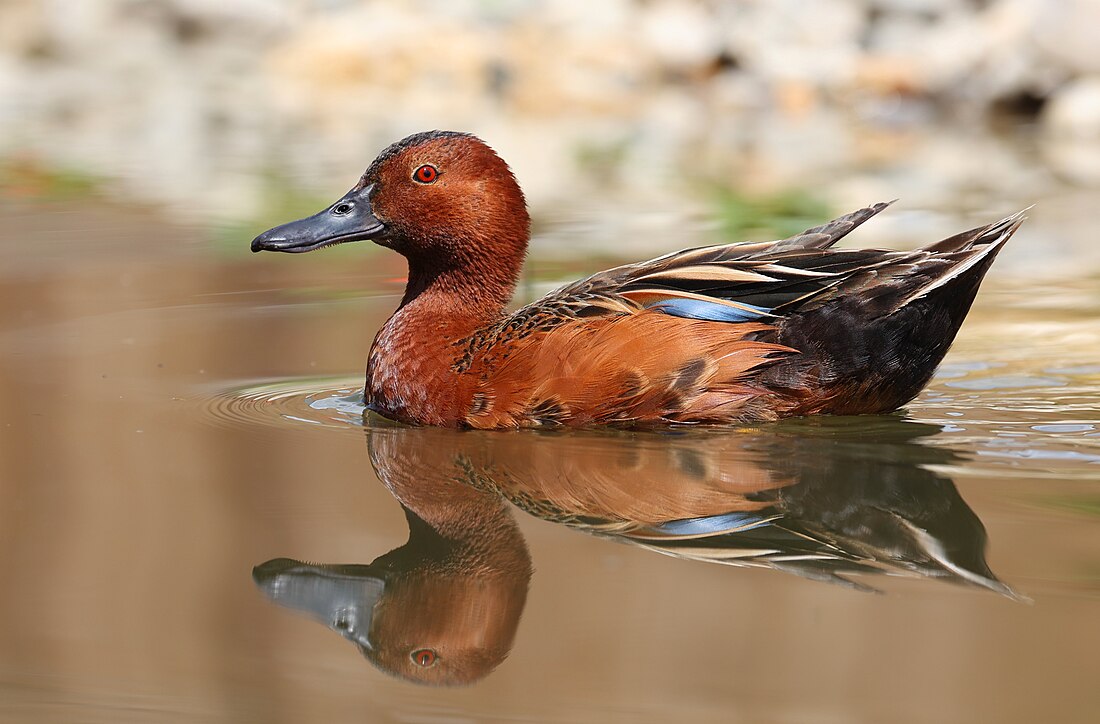Top Qs
Timeline
Chat
Perspective
Cinnamon teal
Species of bird From Wikipedia, the free encyclopedia
Remove ads
The cinnamon teal (Spatula cyanoptera) is a species of duck found in western North and South America. It is a small dabbling duck, with bright reddish plumage on the male and duller brown plumage on the female. It lives in marshes and ponds, and feeds mostly on plants. The cinnamon teal duck is closely related to the north american dabbling duck.(Wilson et al.)
Remove ads
Description
Summarize
Perspective
The adult male has a cinnamon-red head and body with a brown back, a red eye and a dark bill. The adult female has a mottled brown body, a pale brown head, brown eyes and a grey bill and is very similar in appearance to a female blue-winged teal; however, its overall color is richer, the lores, eye line, and eye ring are less distinct. Its bill is longer and more spatulate. Male juvenile resembles a female cinnamon or blue-winged teal but their eyes are red.[2][3] They are 16 in (41 cm) long, have a 22-inch (560 mm) wingspan, and weigh 14 oz (400 g).[3] They have 2 adult molts per year and a third molt in their first year.[3]
- Female Spatula cyanoptera septentrionalium
- Male (left) and female
- Male
Habits and Lifestyle
The Cinnamon Teal Duck is an aquatic bird, but it can also run and walk on land to catch certain prey like little bugs and insects. When they aren't skimming the water or the land for bugs, they sleep. The females sleep together in a huddle, while the males stay awake and alert to protect the females. Ducks usually make a loud quacking sound, but the Cinnamon Teal is a quieter duck. Females will make a loud "quack" when needed to and the males will produce a nasal, whistling song.
Remove ads
Distribution
Their breeding habitat is marshes and ponds in western United States and extreme southwestern Canada, and are rare visitors to the east coast of the United States.[3] One young male duck was spotted in Grimsby, Ontario, and became a tourist attraction due to its rarity outside of western Canada.[4] Cinnamon teal generally select new mates each year. They are migratory and most winter in northern South America and the Caribbean,[5] generally not migrating as far as the blue-winged teal. Some winter in California and southwestern Arizona.[2] Two subspecies of cinnamon teal reside within the Andes of South America. The smaller sized S. c. cyanoptera is widespread within low elevations (<1000m) such as the coast of Peru and southern Argentina, whereas the larger size subspecies S. c. orinomus occupies elevations of 3500–4600 meters in the central Andes.[6]
Remove ads
Behavior
Cinnamon Teal ducks are dabbling ducks which mean they take most of their food at or near the surface by rapidly opening and closing the bill to take seeds, zooplankton, and insects. They can also feed like Northern Shovelers following each other in tight groups as they slowly feed across on area. Many of them eat plants, seeds an shoots of marsh grasses. A small portion of their diet is snails, beetles, dragonflies, water fleas, and many types of flies. They mainly eat plants; their diet may also include molluscs and aquatic insects.[7]
Taxonomy
They are known to interbreed with blue-winged teals,[2] which are very close relatives.
Subspecies are:
- Spatula cyanoptera septentrionalium (Oberholser, 1906) northern cinnamon teal breeds from British Columbia to northwestern New Mexico, and they winter in northwestern South America.[8]
- Spatula cyanoptera tropica (Snyder & Lumsden, 1951) tropical cinnamon teal occurs in the Cauca Valley and Magdalena Valley in Colombia.[8]
- Spatula cyanoptera borreroi (Snyder & Lumsden, 1951) Borrero's cinnamon teal (possibly extinct) occurs in the eastern Andes of Colombia with records of apparently resident birds from northern Ecuador.[8] It is named for Colombian ornithologist José Ignacio Borrero.
- Spatula cyanoptera orinoma (Snyder & Lumsden, 1951) Andean cinnamon teal occurs in the Altiplano of Peru, northern Chile and Bolivia.[8]
- Spatula cyanoptera cyanoptera (Vieillot, 1816) Argentine cinnamon teal occurs in southern Peru, southern Brazil, Argentina, Chile, and the Falkland Islands.[8]
Remove ads
References
Works cited
External links
Wikiwand - on
Seamless Wikipedia browsing. On steroids.
Remove ads








